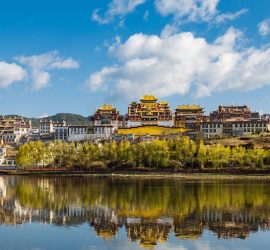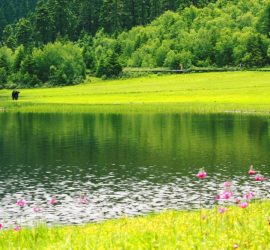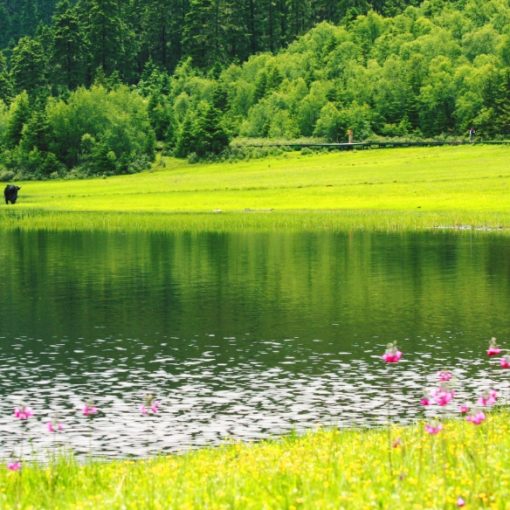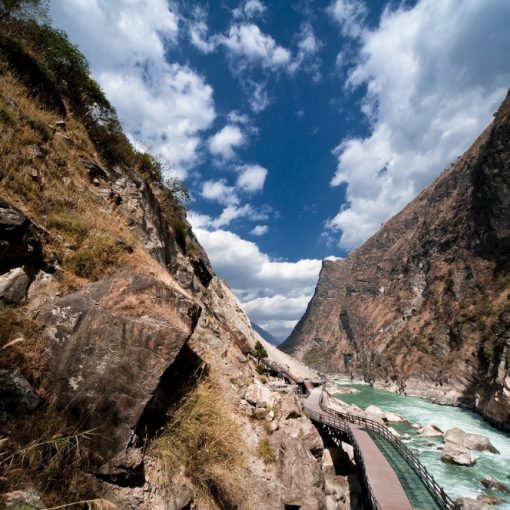The First Bend of the Yangtze River is one of China’s most magnificent natural phenomena, known for its dramatic 180-degree turn. This natural wonder is not only a breathtaking sight but also holds significant geographical, cultural, and historical importance. Located in the Yunnan province near the town of Shigu, this unique bend marks a pivotal point where the river shifts direction, impacting the landscape and the lives of the people around it. This article delves into the intricate details of the First Bend of the Yangtze River, exploring its geological formation, ecological significance, cultural impact, and its role in tourism.
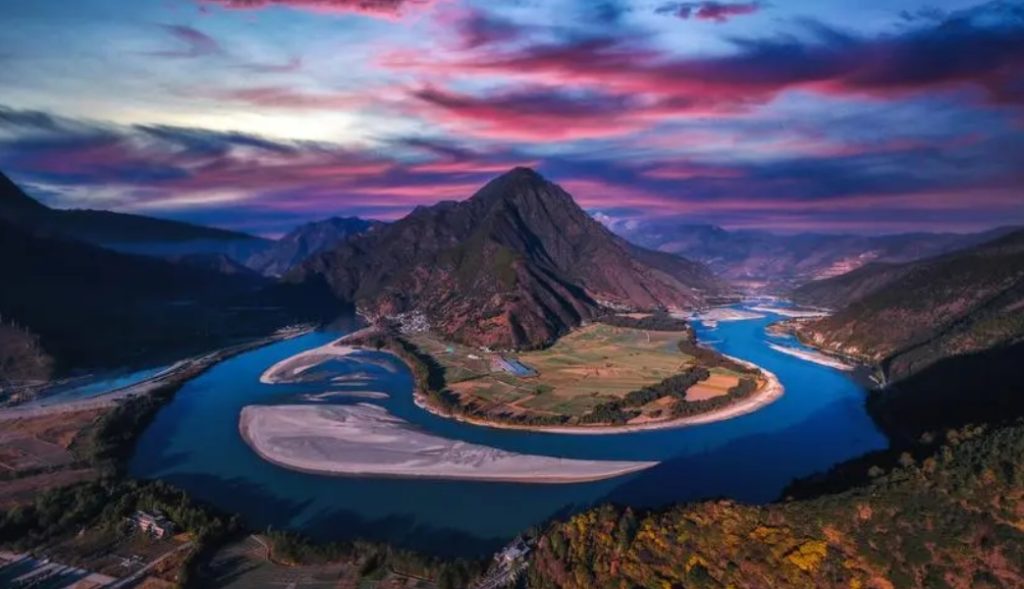
Brief Introduction
The Yangtze River, the longest river in Asia and the third-longest in the world, stretches over 6,300 kilometers from the Tibetan Plateau to the East China Sea. The First Bend of the Yangtze River is located in the Yunnan province, approximately 50 kilometers from Lijiang. This iconic bend occurs as the river flows southeast before abruptly turning northward, creating a dramatic and picturesque loop. The area around the First Bend is renowned for its stunning natural beauty, rich biodiversity, and vibrant cultural heritage, making it a significant attraction for both nature enthusiasts and cultural explorers.
Geological Formation
The formation of the First Bend of the Yangtze River is a fascinating geological process that has taken millions of years. The bend is the result of the river encountering a massive mountain range, the Shigu Mountain, which forces the river to make a sharp turn. This geological feature is part of the larger Hengduan Mountains, a series of parallel mountain ranges that run through southwestern China. The interaction between the river and the mountains has created a unique landscape characterized by deep gorges, towering peaks, and lush valleys.
Details of Geological Formation:
- Tectonic Activity: The formation of the Hengduan Mountains and the resulting bend in the Yangtze River is largely due to tectonic activity. The collision between the Indian Plate and the Eurasian Plate has uplifted the region, creating the mountain ranges and altering the course of the river.
- Erosion and Sedimentation: Over millions of years, the Yangtze River has carved its way through the mountains, creating deep gorges and depositing sediments along its course. The process of erosion and sedimentation has shaped the landscape, contributing to the formation of the First Bend.
- Hydrological Impact: The sharp turn in the river has significant hydrological implications, affecting the flow and distribution of water. The bend creates a unique hydrodynamic environment, influencing the surrounding ecosystems and the river’s overall behavior.
Ecological Significance
The First Bend of the Yangtze River is not only a geological marvel but also a region of immense ecological importance. The diverse habitats created by the river and the surrounding mountains support a wide range of plant and animal species. The area is part of the Three Parallel Rivers of Yunnan Protected Areas, a UNESCO World Heritage site known for its exceptional biodiversity.
Details of Ecological Significance:
- Flora and Fauna: The unique microclimates and varied topography of the region support a rich diversity of plant and animal life. The area is home to several endemic species, including rare plants and endangered animals such as the Yunnan snub-nosed monkey and the black-necked crane.
- Aquatic Ecosystems: The river itself supports a variety of aquatic life, including numerous fish species, some of which are endemic to the Yangtze River basin. The complex hydrodynamics created by the bend influence the distribution and behavior of these aquatic organisms.
- Conservation Efforts: The ecological significance of the region has led to various conservation initiatives aimed at preserving its unique biodiversity. Efforts include habitat protection, research on endemic species, and sustainable tourism practices to minimize human impact on the environment.
Cultural and Historical Impact
The First Bend of the Yangtze River holds profound cultural and historical significance for the people of the region. The area around the bend has been inhabited for thousands of years, and it has played a crucial role in the development of local cultures and civilizations.
Details of Cultural and Historical Impact:
- Historical Routes: The bend is located near the ancient Tea Horse Road, a vital trade route that connected Yunnan with Tibet and beyond. This historical route facilitated the exchange of goods, culture, and ideas, contributing to the region’s rich cultural tapestry.
- Ethnic Diversity: The area is home to several ethnic minority groups, including the Naxi, Tibetan, and Bai people. Each group has its own unique traditions, languages, and customs, many of which are closely tied to the river and the surrounding landscape.
- Cultural Heritage: The First Bend is associated with numerous legends and historical events, many of which are commemorated in local folklore and cultural practices. The river itself is considered sacred by many local communities, and it features prominently in their cultural and religious life.
Tourism and Economic Impact
The First Bend of the Yangtze River is a major tourist attraction, drawing visitors from around the world. The region’s stunning natural beauty, rich cultural heritage, and historical significance make it a must-visit destination for travelers.
Details of Tourism and Economic Impact:
- Tourist Attractions: The First Bend is surrounded by several other notable attractions, including the Tiger Leaping Gorge, the ancient town of Shigu, and the scenic Jade Dragon Snow Mountain. These sites, combined with the natural beauty of the bend, create a diverse and appealing tourist destination.
- Economic Benefits: Tourism has brought significant economic benefits to the region, providing income and employment opportunities for local communities. The development of tourism infrastructure, such as hotels, restaurants, and transportation services, has contributed to the economic growth of the area.
- Sustainable Tourism: Given the ecological and cultural importance of the region, there is a strong emphasis on sustainable tourism practices. Efforts include promoting eco-friendly tourism, supporting local businesses, and preserving the natural and cultural heritage of the area.
Visitor Experience
Visiting the First Bend of the Yangtze River offers a unique and memorable experience for travelers. From the breathtaking views and outdoor adventures to the rich cultural encounters and historical exploration, there is something for everyone.
Details of Visitor Experience:
- Scenic Views: The First Bend offers some of the most spectacular scenic views in China. Visitors can enjoy panoramic vistas of the river and mountains, with opportunities for photography, hiking, and nature observation.
- Cultural Encounters: Interacting with the local communities provides a deeper understanding of the region’s cultural heritage. Visitors can experience traditional music, dance, cuisine, and crafts, gaining insight into the lives and traditions of the ethnic minority groups.
- Historical Exploration: Exploring the historical sites and learning about the ancient trade routes, legends, and historical events associated with the bend adds an enriching dimension to the visit. The nearby town of Shigu, with its historical monuments and museums, offers a fascinating glimpse into the region’s past.
Challenges and Future Prospects
Despite its many attractions, the First Bend of the Yangtze River faces several challenges that need to be addressed to ensure its preservation and sustainable development.
Details of Challenges and Future Prospects:
- Environmental Threats: The region is vulnerable to environmental threats such as deforestation, pollution, and climate change. These threats can impact the delicate ecosystems and biodiversity of the area, necessitating robust conservation efforts.
- Balancing Development and Preservation: Balancing tourism development with the preservation of natural and cultural heritage is a key challenge. Sustainable tourism practices and policies are essential to mitigate the impact of tourism on the environment and local communities.
- Community Involvement: Engaging local communities in conservation and tourism development efforts is crucial for the long-term sustainability of the region. Empowering local people through education, training, and economic opportunities can foster a sense of ownership and responsibility towards preserving their heritage.
The First Bend of the Yangtze River is a remarkable natural wonder that offers a rich tapestry of geological, ecological, cultural, and historical significance. Its unique geological formation, diverse ecosystems, and vibrant cultural heritage make it a fascinating destination for travelers and a valuable site for researchers and conservationists. The preservation and sustainable development of the region are essential to ensure that this extraordinary natural and cultural treasure continues to captivate and inspire future generations. As one of China’s most iconic landmarks, the First Bend of the Yangtze River stands as a testament to the enduring beauty and complexity of the natural world and the rich cultural legacy of the people who inhabit it.

